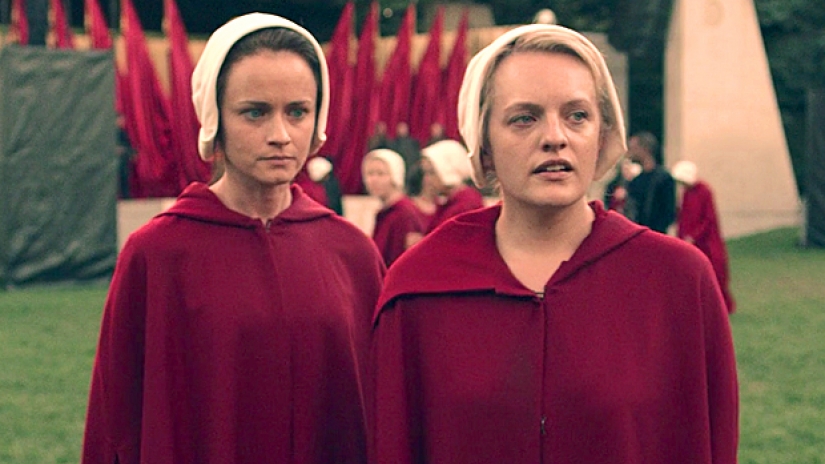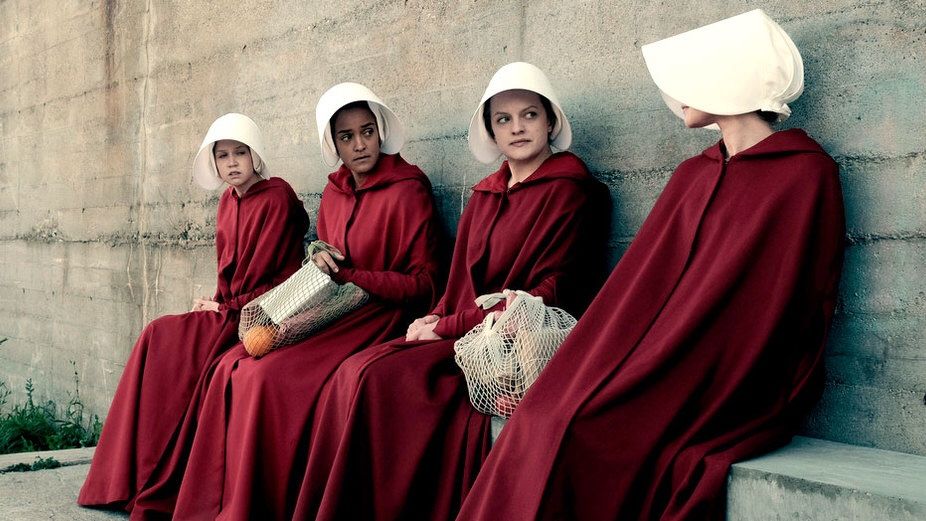
Why ‘The Handmaid’s Tale’ Has Become a Feminist Life Raft
Through Weinstein and Diddy, Roe v Wade and the manosphere, Elisabeth Moss’ June has made it all bearable.

When Hulu began releasing the first season of The Handmaid’s Tale in 2017, the parallels between the show and real life were stark.
The series had introduced Elisabeth Moss as June, a mother and wife who was captured by the totalitarian fascist regime the Republic of Gilead that had overthrown the U.S. government. Gilead, which is governed by men, is disguised as a theocratic society but really is built on trampling the rights of women and even on a culture of rape.

In those first episodes, viewers watched via flashbacks as June’s rights, along with those of every woman she knew, were gradually stripped away. Series creator Bruce Miller and his team illustrated in terrifying detail the step-by-step process of how Gilead blindsided a fictional world entering a global fertility crisis and forced largely underclass women into being birth “handmaids” for the elite. [Editor’s note: This story contains spoilers for the final season of The Handmaid’s Tale.]
Based on the acclaimed novel Margaret Atwood published in 1985 amid the rise of Reaganism and the Moral Majority, the streaming series was intended to be set in the possible near future when it was officially greenlit in early 2016. But by the time it debuted, the show wasn’t projecting five years ahead — it felt like five seconds. President Trump had gotten a few months into his shock presidency. Women’s marches had flooded city streets around Trump’s inauguration. And now The Handmaid’s Tale was showing its main characters nearly gunned down at similar protests.

The show quickly became an emblem of real-world resistance. The red cloaks and white bonnets worn by the handmaids in the series were being donned by protesters nationwide as feminist symbols. At Planned Parenthood’s 100th anniversary event, Hillary Clinton paraphrased Atwood: “We can never let them grind us down,” she said, before alluding to a line from the series: “It is not too late for us.” The series had suggested it became too late because people were too busy staring at their phones. That warning hasn’t quit being prophetic.
In the years since the show debuted, #MeToo flashpoint Harvey Weinstein went on trial (then went on trial again and then again); the late Jeffrey Epstein was arrested for sex trafficking; Roe v. Wade was overturned; Trump was found liable for sexual abuse; Sean “Diddy” Combs was charged with sex trafficking; shows and podcasts about the manosphere have been on the ascent; and Trump has returned to the White House.
Through it all, June has been our avatar and guide. Before Gilead, she was any one of us — a loving mother and wife, a cool friend with a job in the arts. We watched in horror as Gilead tried to destroy that identity by putting her through abuse that no person should have to endure. Ironically, the resurgence of misogyny helped cement the show’s legacy as a feminist antidote. “Don’t let the bastards grind you down” was June’s timely rallying cry.
June isn’t real. But as the sixth and final season of the Emmy winner has wound down this spring, she and her handmaids became an army. Did she know she was building an army in her audience, too? We watched her do the impossible as she escaped her oppressors and started a revolution, making us want to raise our collective fists. We saw in her quiet leadership how she used allies and organized a stealth resistance movement to fight back in ways that matter.
And she has done this all as a mother who is grieving her eldest daughter. Ever since I first watched The Handmaid’s Tale, I’ve wanted what everyone has wanted — for June to get her daughter back. Her older daughter, Hannah, was ripped from her arms in the pilot. But by the end of the series, Hannah remains in Gilead. Despite June’s heroic efforts, we see her do the unthinkable: She decides to go back into Gilead in an excruciating Sophie’s Choice moment. She leaves her youngest daughter, Nichole, with her own mother and remains with the resistance, vowing to never stop until she gets Hannah back. In the final scene of the series, she pauses to start recording her tale — The Handmaid’s Tale we’ve been watching.

Imagining a future without The Handmaid’s Tale isn’t easy given these fraught times for feminism. “I cannot believe that as a woman I have fewer rights now than when I started on the show in 2017,” season six showrunner Yahlin Chang said recently. Added original costume designer Ane Crabtree, “When I see the cloaks being used as a symbol of resistance, it makes me really nostalgic for the moments that it was just a cloak.”
Atwood, at least, offers reason for optimism. When she published her book, phrases like “a woman’s place is in the home” were gaining new currency. “I wondered, how are you going to get them all back in there since they were running around having credit cards and jobs?” she recently recalled, a bit of inspiration that remains stubbornly durable today.
Onscreen, the storylines will continue in the forthcoming Hulu-MGM sequel series, The Testaments, adapted from Atwood’s follow-up novel in which Ann Dowd’s Aunt Lydia will reprise her role as an educator of young girls raised in Gilead, likely including Hannah.
Meanwhile, Moss keeps on behind the scenes as TV’s Gilead universe expands. Her role as June remains intentionally nebulous. We may not see her because she’s undercover, fighting.
In heartbreak lives hope, and if June isn’t hanging up her cloak, then neither can any of us. It might not be the conclusion we wanted. But it’s the one we need.
This story first appeared in a June stand-alone issue of The Hollywood Reporter magazine. To receive the magazine, click here to subscribe.